New
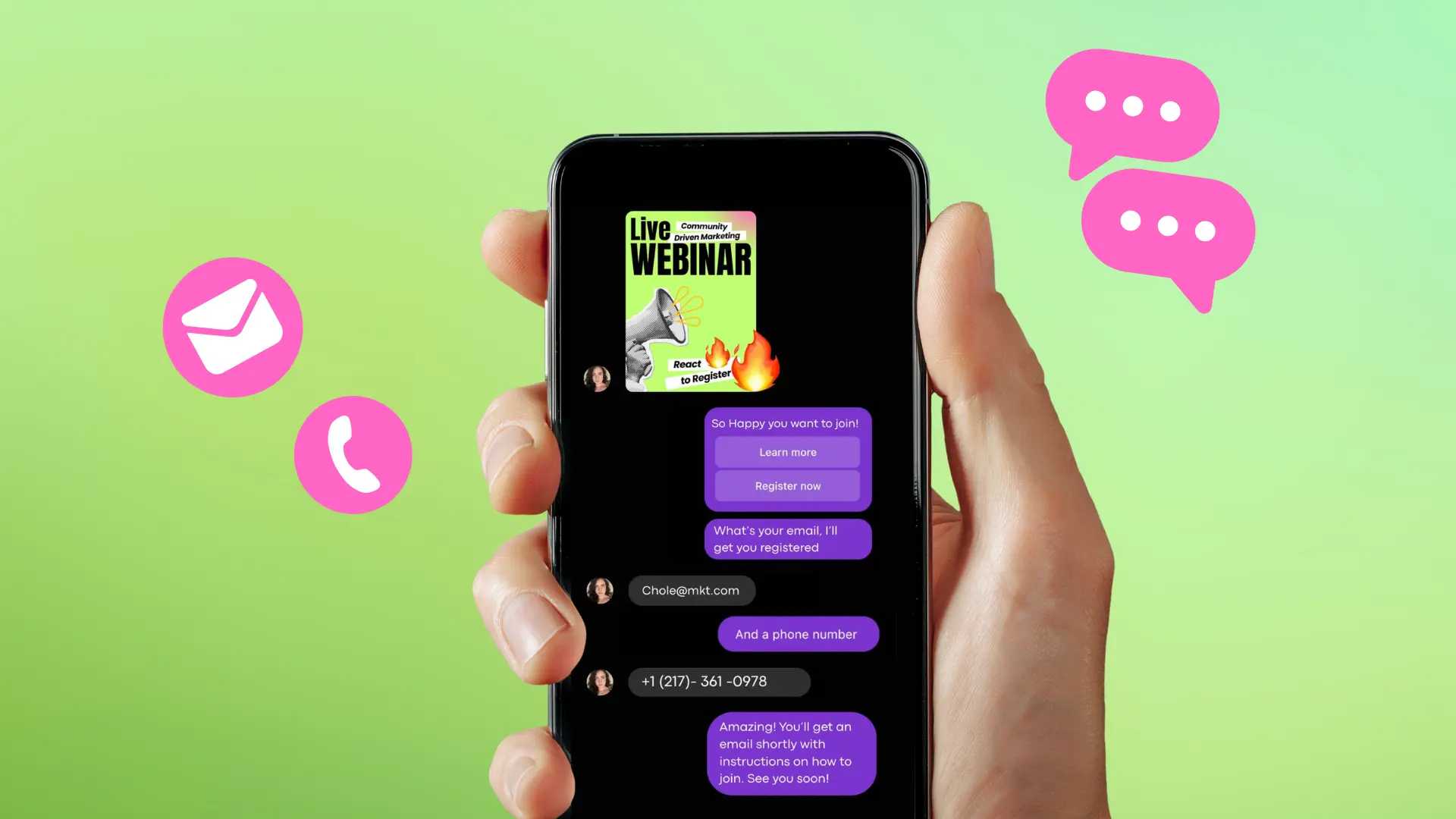
Turn Your DMs Into Lead Gen!
Learn how to collect lead data from your DMs such as email addresses, phone numbers, and more right from your social inbox. If you are not yet automating your DMs your competitors are outpacing you.

How Something Social Saved 75% of Their Time and Increased Revenue by 15%
See how a fast-growing agency improved operations, cut down hours of manual work, and unlocked new revenue opportunities with Vista Social.
New
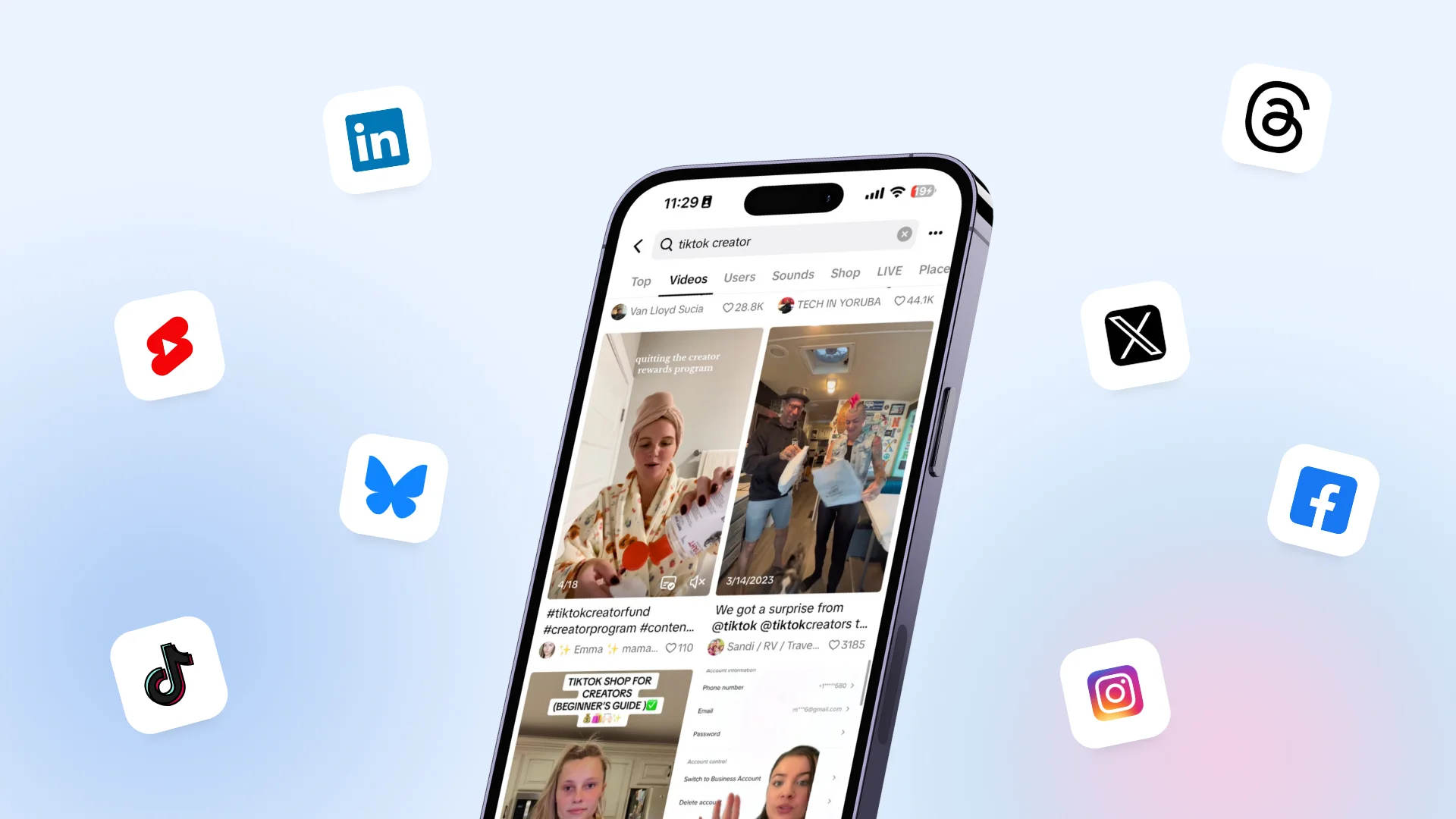
50 Unique Social Media Ideas for Consistent Content Creation
Discover 50 unique social media post ideas to engage your audience, grow your brand, and maintain a consistent content strategy with ease!
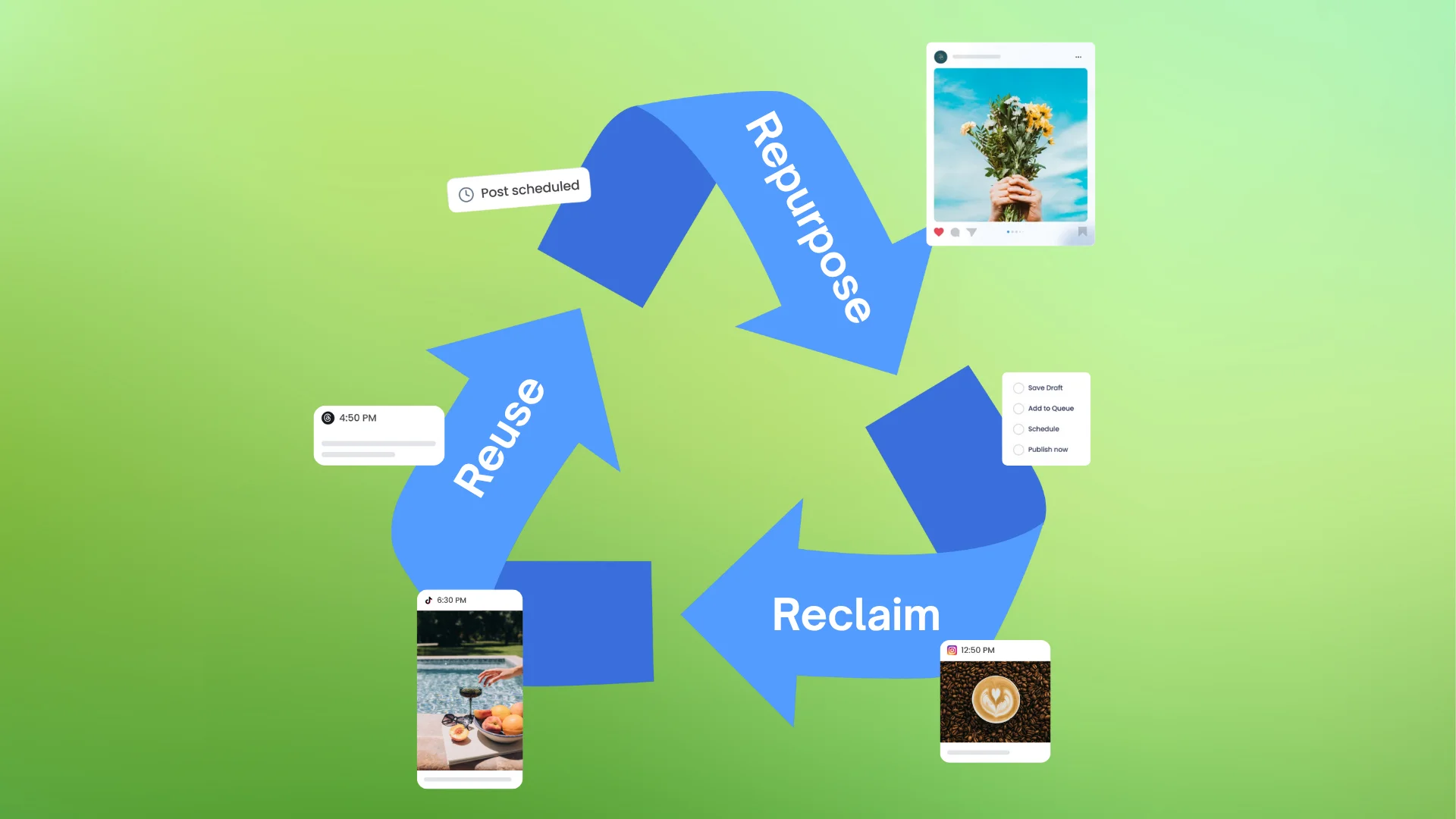
Mastering Content Reuse: The Key to a Consistent and Sustainable Posting Strategy
Published on August 18, 2025
12 min to read
Predictive Analytics for Content Planning: Using Vista Social Trends
Summarize with AI
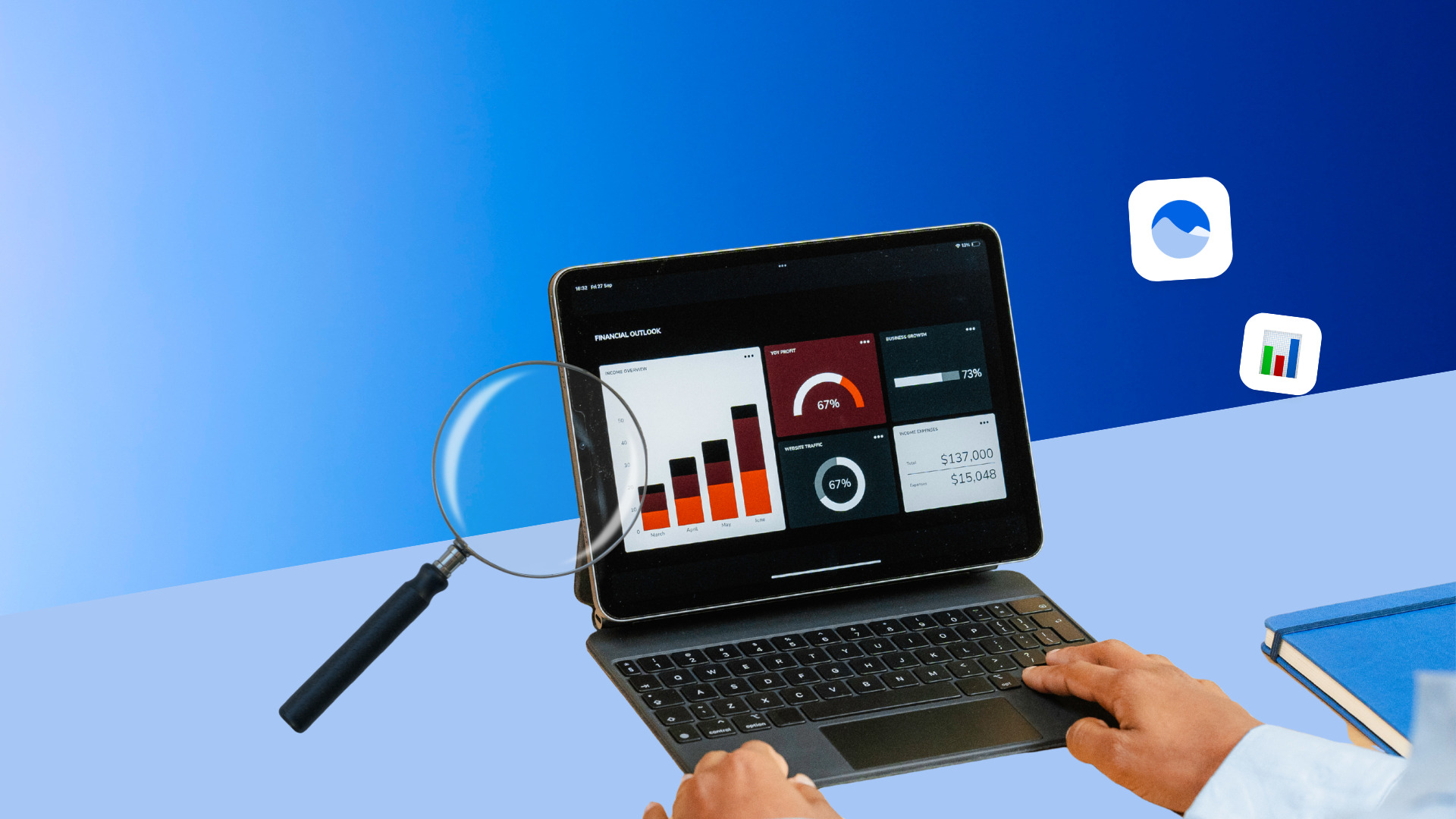

Table of Content

Tired of the dreaded “What should we post next?” panic?
With predictive analytics for content planning, it’s like hitting the ‘easy button’ for your next post.
As a social media manager, you’re already juggling deadlines, chasing trends, and trying to keep audiences engaged.
The problem?
By the time you notice a trend, it’s usually old news.
That’s why Vista Social’s Trends feature is a game-changer.
It shows you what’s likely to take off before it clogs everyone’s feed—so you can plan ahead with confidence.
No more last-minute scrambles.
Just data-driven decisions, smoother workflows, and maybe even time for that extra coffee break ☕😉.
Let’s explore how predictive analytics can shift your planning from reactive to proactive—and turn your content into an engagement powerhouse.
Table of contents
What is predictive analytics for content planning?
Predictive analytics for content planning is the process of using patterns, historical data, machine learning, and Artificial Intelligence (AI)-powered forecasting to figure out what content is most likely to perform well in the future before you post it.
It’s like having a weather forecast for your clients’ social media engagement.
Instead of guessing which content formats, topics, or hashtags may land, predictive data analytics looks at past performance, audience behavior, seasonal trends, and even platform algorithm shifts to make informed recommendations.
What are the benefits of predictive analytics for content planning?
Leveraging predictive analytics to plan your clients’ social media content offers several benefits.
Stay ahead of future trends
One of the most frustrating parts of managing your clients’ social media campaigns is jumping on a trend just as it starts to fade.
Predictive analytics solves this by identifying emerging topics, hashtags, and formats before they go mainstream.
[Must read: Predictive Analytics for Social Media: Forecasting Trend Performance]
With this early insight, you can develop strategies to make your clients’ brands leaders in the conversation, not the ones scrambling to catch up.
Plan content with confidence
Gone are the days of the “throw it out there and hope it works” approach.
Predictive analytics shows you exactly what’s likely to resonate with your clients’ audiences based on historical data, audience behavior, and engagement patterns.
It means that every piece of content you create has a higher chance of hitting the mark, giving you confidence in your social media strategy.
Maximize engagement
The right message at the right time can be the difference between a successful and failing marketing campaign and strategy.
Predictive analytics helps you match content to the times your clients’ audiences are most active and to the topics they’re most interested in.
The result?
Higher likes, shares, comments, and overall audience interaction.
Save time and reduce stress
When you know what topic, hashtag, or format is going to work, you can plan weeks (or even months) in advance.
It can mean fewer late nights scrambling to fill content gaps and more time to focus on creative social media strategy.
Predictive analytics essentially acts as your content roadmap, guiding you away from last-minute chaos.
Improve ROI on Social Efforts
Every social media post is an investment of your team and clients’ time, effort, and often money.
Predictive analytics ensures those investments are made wisely, focusing on content that’s more likely to drive measurable results.
Whether sales, sign-ups, or brand awareness, predictive analytics equips you with valuable data insights.
You can leverage the insights to develop strategies to ensure stronger returns without wasting resources on underperforming content.
How to use Vista Social Trends for predictive analytics for content planning
Skip the guessing game and predict what content will resonate with your clients’ audiences next week, month, or quarter like a boss with Vista Social.
The Vista Social Trends feature within the platform’s analytics tool can help you turn real-time and historical data into predictive insights that fuel better content strategies.
To view report trends, you’ll need to run your reports first.
After logging into Vista Social, select Reports > Run report on the main menu (left-hand-side panel).
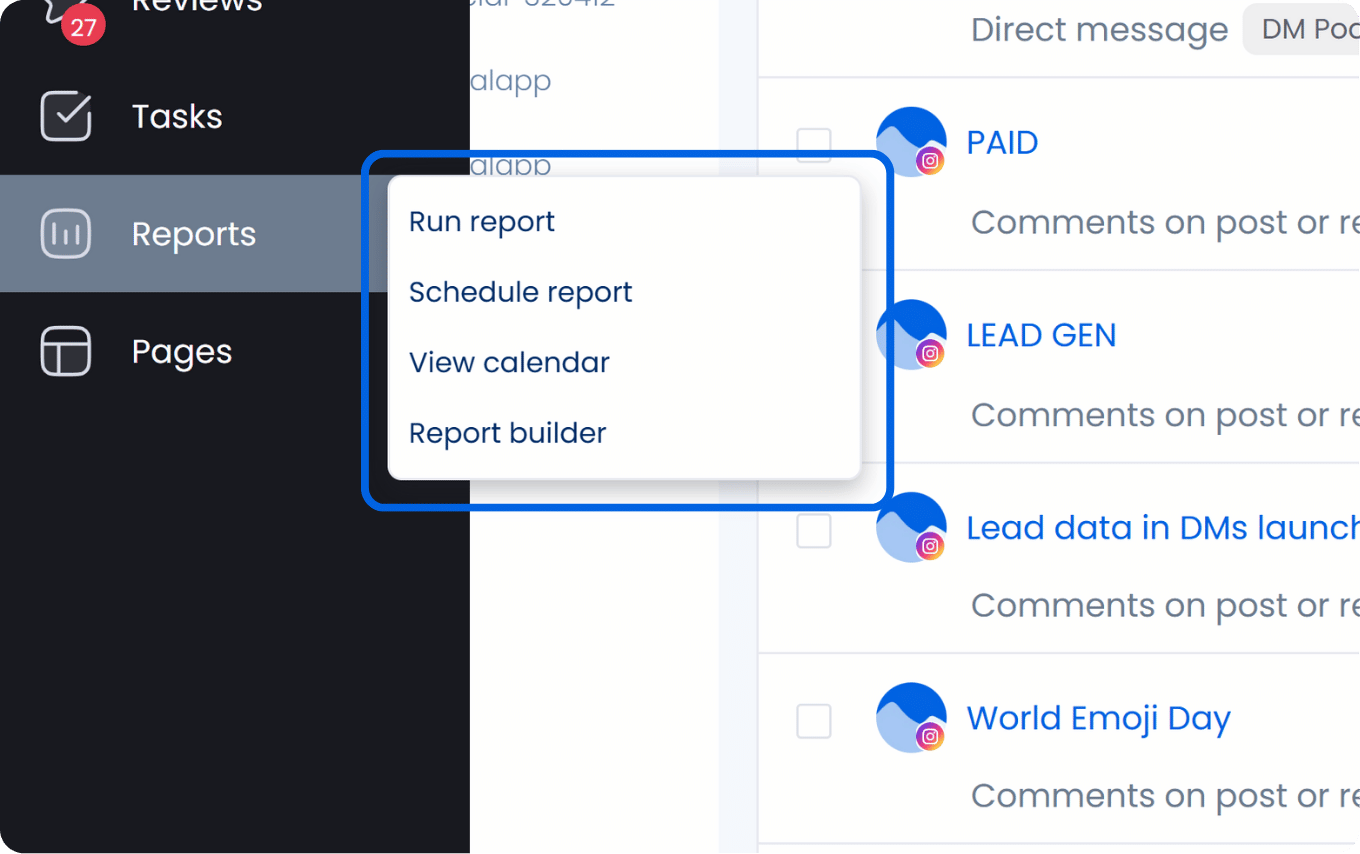
If you click View calendar, you can also run your report by selecting the Run report dropdown on the top-right corner and clicking Run report.
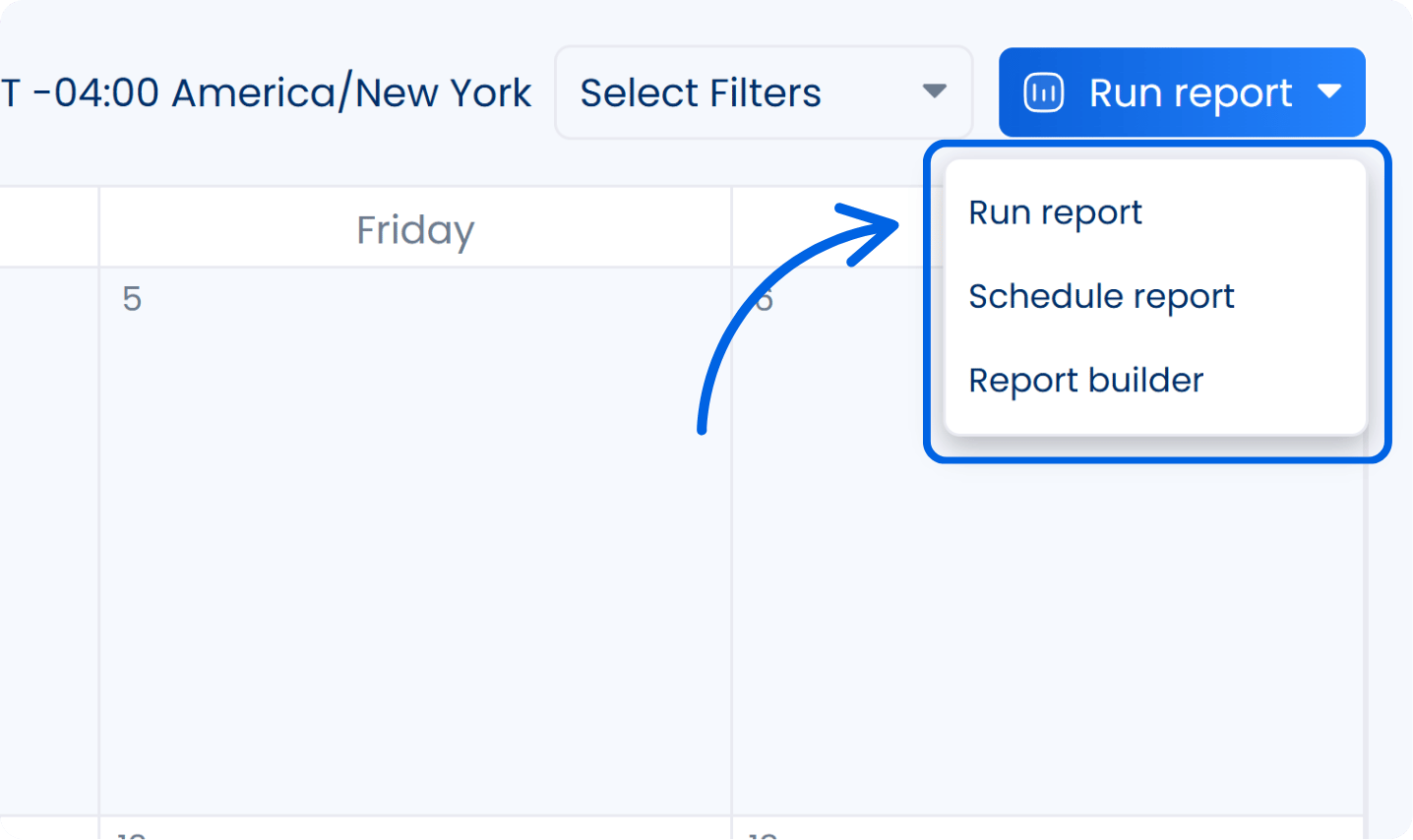
Next, select your report type (Trends are built into your Vista Social reports).
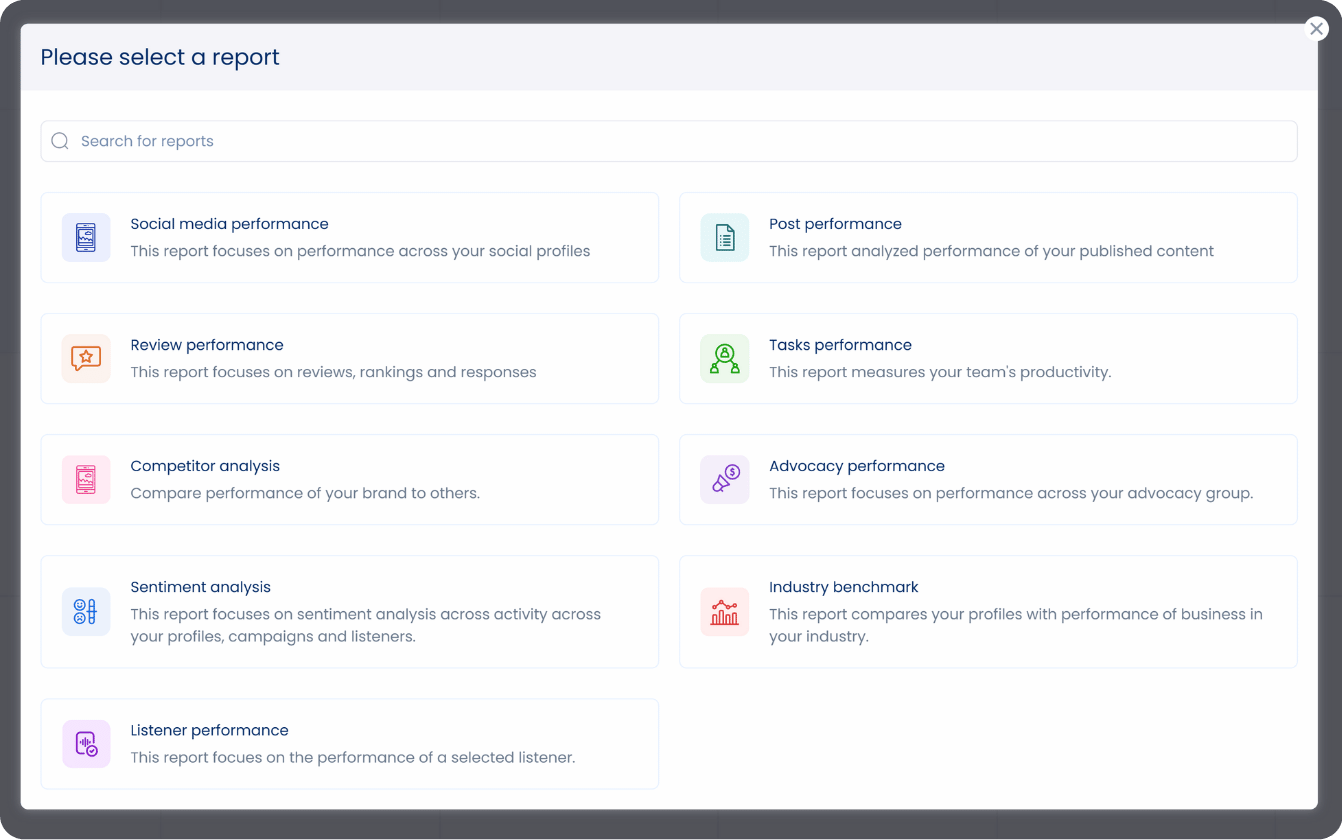
For example, if you run a Post Performance report, you can track and view metrics that show crucial audience growth, hashtags, and engagement trends.
Specify the date range and period of comparison for the data and trends you want to see in your report.
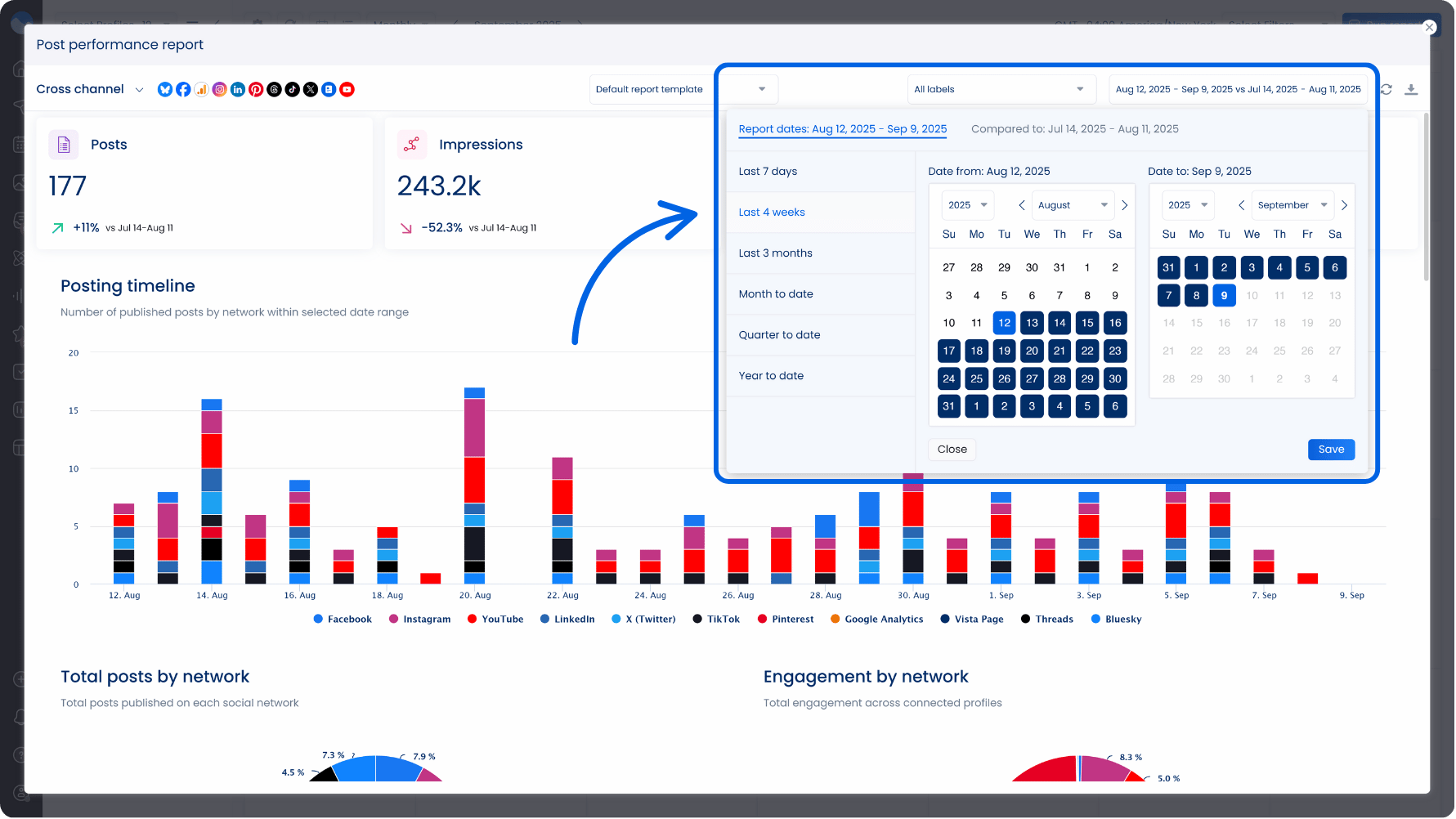
You can drill down on the data that matters most to your team’s and clients’ current goals by:
- Setting the range to the same time last year for seasonal insight to get relevant data for your Q4 content planning
- Check data from the last seven to 14 days to spot emerging trends
After running your report, you can now go over your report metrics, charts, and insights to uncover essential trends.
For example, in this report below, we can see audience growth and post impressions.
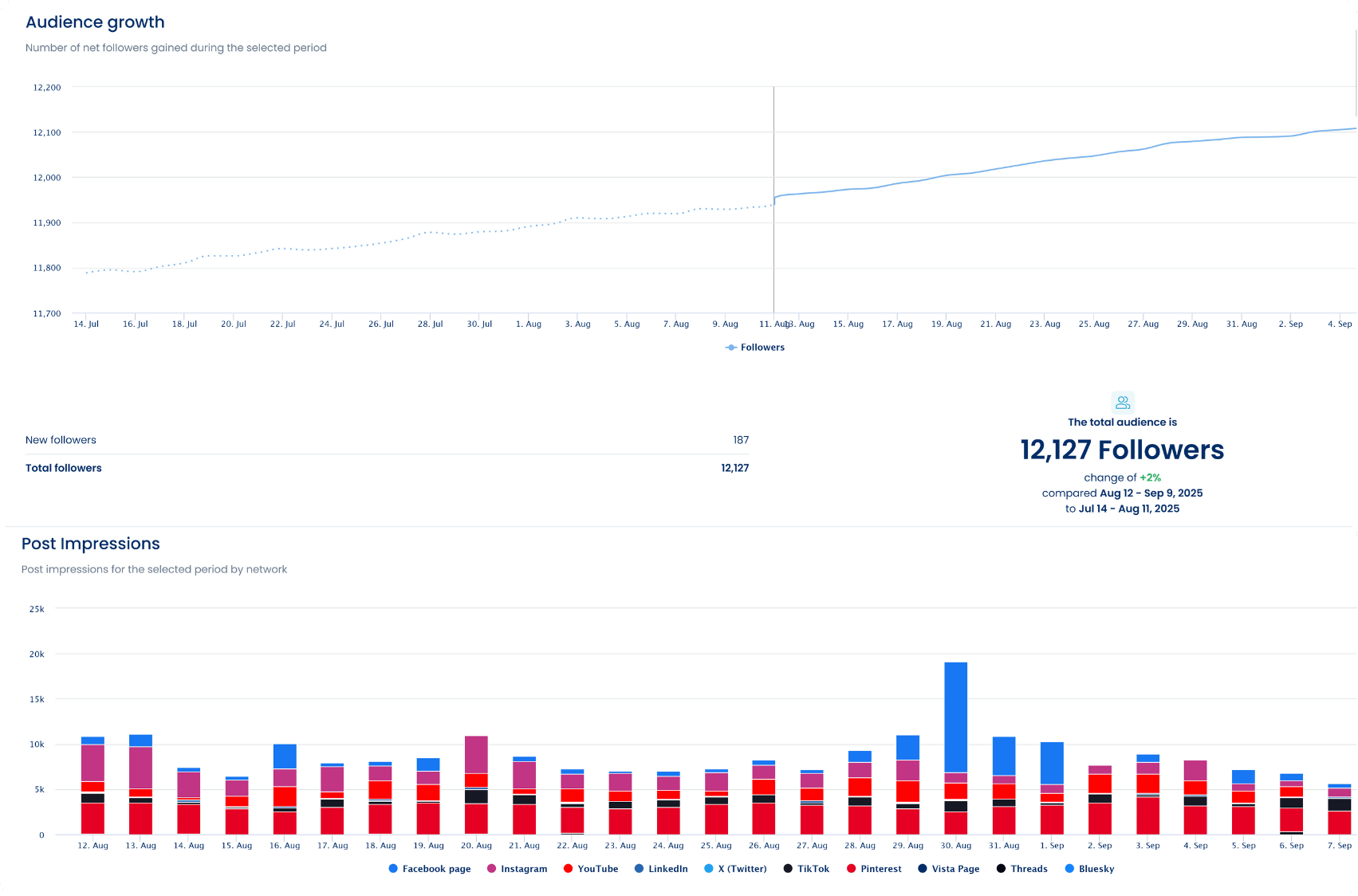
And here, we can see overall engagement plus your top hashtags based on interactions.
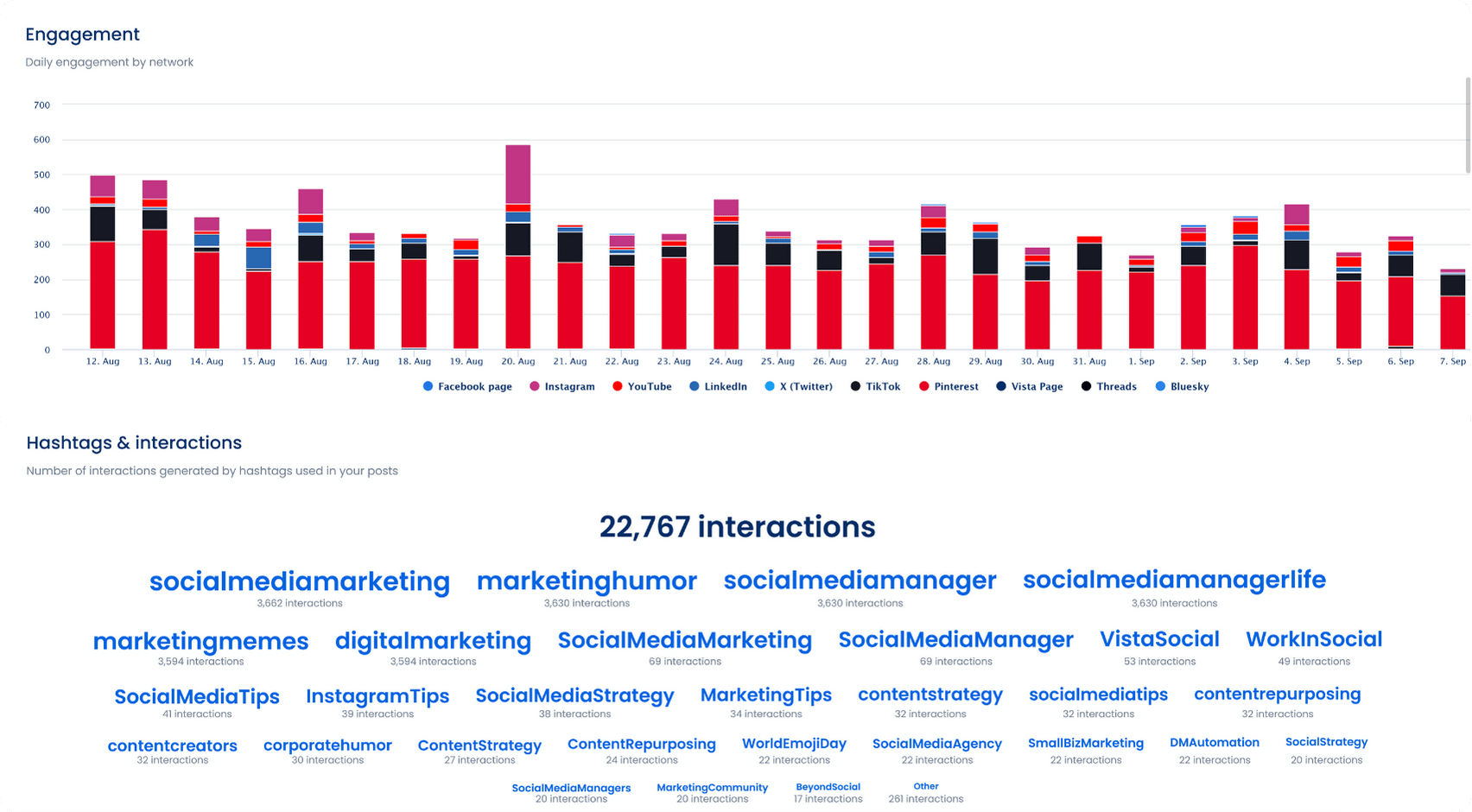
When going over your reports, you can review your clients’ best-performing posts.
Pay attention to the content type, format (carousel, video, text-only), post timing, and engagement metrics.
Uncover trends by checking the following:
- What the posts have in common
- Whether there are trends in the content type or topic
- If certain posts perform better on specific days
These can be the foundation for forecasting future winners.
For instance, if you run a Social Media Performance report for your client’s Instagram account, the Online followers graph shows the number of followers online during specific hours of the day within your specified date period.

The trend helps you understand when your clients’ followers are most active.
Additional tip: Look for repeated engagement spikes since those can be crucial indicators of predictable audience behavior you can plan around.
You can also schedule your reports on Vista Social to automatically generate and send them to your team members and clients.
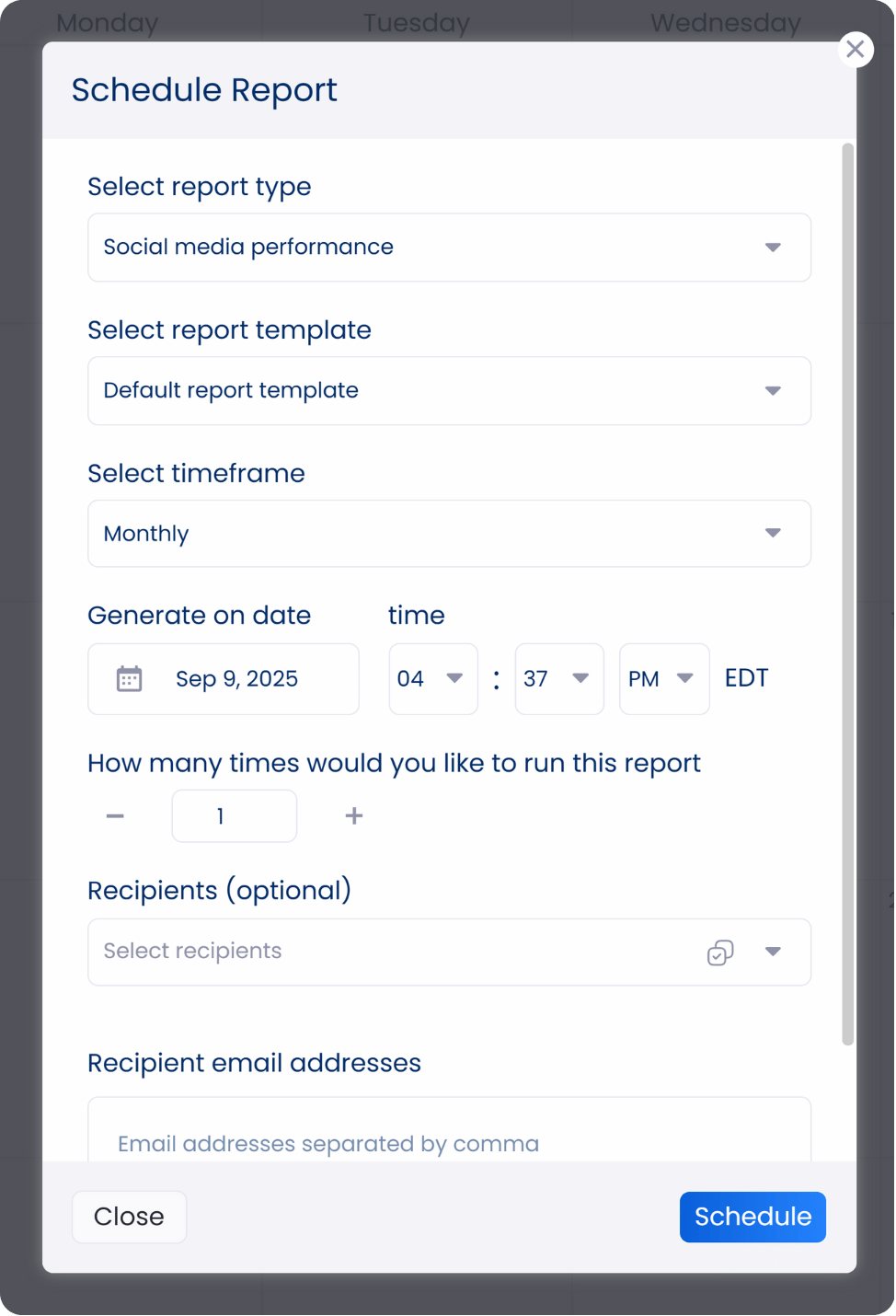
Other report sharing options include exporting your reports to PDF or CSV files or sharing direct, interactive report links.

Vista Social has more to offer, including the following features.
- Content scheduling
- A collaborative content calendar with approval workflows
- Engagement management via a unified Social Inbox
- Employee advocacy
- An AI Assistant
- Link in bio tool (Vista Page)
- DM Automations
- Social listening with sentiment analysis
[Must read: Social Listening Analytics: A Complete Guide]
Tips for using Vista Social Trends for predictive analytics to plan content
Make the most of Vista Social’s Trends feature to get predictive analytics insights for data-driven content planning with the best practices below.
Identify trend signals
Look for content categories or themes that show sustained upward movement—either in reach, impressions, or engagement.
Examples of trend signals can include:
- Carousel posts that perform increasingly well on Mondays
- Reels that have gotten more shares over the past few weeks
- LinkedIn posts about industry news that consistently outperform product promos
[Must read: LinkedIn Analytics: Complete Guide [w/ metrics, tools, etc.]
By identifying these signals early, your content creation process can stay ahead of the curve.
Plan future content around trends
Once you’ve identified what’s likely to work, start mapping out your upcoming content calendar based on those insights.
Use Vista Social’s built-in social media publishing tools to:
- Repurpose or expand on high-performing topics
- Schedule similar formats for peak engagement times
- Test new variations and track performance in Trends
Monitor and adjust
Trends aren’t static since audience behavior changes.
Keep checking trends data insights weekly or monthly to see if your predictions hold up, and adjust your strategy accordingly.
Think of this as a feedback loop:
- Spot a trend
- Plan content around it
- Watch how it performs
- Refine and repeat
Predictive analytics for content planning: Key metrics to track
Making the most of predictive analytics in your content strategy starts with tracking the right data.
Below are the key metrics you’ll want to keep an eye on to forecast performance and plan content that truly connects with your clients’ audiences.
Engagement Rate
The engagement rate tells you how much your clients’ audiences interact with your content.
We’re talking likes, comments, shares, saves—all the good stuff that shows people care.
Predictive analytics uses this data to spot patterns in how audiences respond to various content formats, captions, or topics.
If your how-to carousels consistently get solid engagement, chances are future posts in that style will do well too.
Tracking this metric over time helps you forecast what will grab attention and spark conversation so you can weave them into your content strategy.
Click-Through Rate
Click-Through Rate (CTR) is your go-to metric if you’re trying to drive traffic—whether to your clients’ websites, landing pages, or product links.
CTR shows how often people click on your clients’ posts after seeing them.
Predictive models analyze which visuals, headlines, or Calls-to-Action (CTAs) lead to the highest click rates.
For example, if your link posts with curiosity-driven captions get more clicks than straightforward ones, you’ll know what direction to lean into for future content that gets people to take action.
Reach and Impressions
Try Vista Social for Free
A social media management platform that actually helps you grow with easy-to-use content planning, scheduling, engagement and analytics tools.
Get Started NowReach shows the number of unique people who saw your content, while impressions reflect the total number of times it was seen.
The metrics are crucial for understanding the visibility of your social media content.
Predictive analytics looks at past posts to see what types of content tend to get more reach, such as Instagram Reels or trending audio on TikTok.
[Must read: 15 TikTok Analytics Tools Worth Trying this 2025]
If certain posts consistently perform better in terms of reach, that’s your signal to create content more like them and expand your clients’ audience exposure.
Follower growth rate
Sure, follower count is a vanity metric if it’s all fluff, but your growth rate over time?
That’s an undeniable goldmine.
Predictive analytics uses follower trends to forecast how your content may affect future growth.
If your behind-the-scenes TikTok posts or educational YouTube videos attract more new followers, the data will show it.
[Must read: YouTube Shorts Analytics Explained: An A–Z Breakdown]
With this insight, you can double down on content that not only retains followers but also brings in new ones.
Saves and Shares
Likes are great, but saves and shares are next-level indicators that your clients’ social media posts are truly valuable.
Saves mean someone wants to come back to it later, while shares mean it was good enough to show a friend.
These actions tell predictive models which types of content have long-term or viral appeal.
If your Snapchat Snaps are getting saved and shared, chances are similar content will perform well again.
It gives you a reliable go-to content style.
[Must read: Snapchat Analytics Ultimate Guide: What to Track, FAQs, Etc.]
Sentiment Analysis
It’s not just about what people say but also about how they feel when they say it.
Sentiment analysis looks at the tone of comments, Direct Messages (DMs), and mentions to determine if audiences are reacting positively, negatively, or neutrally.
Predictive tools track sentiment changes to forecast potential PR risks or shifts in your clients’ brand perception.
If feedback starts trending negative around a certain topic, you’ll know to pivot your clients’ messaging before things escalate.
Conversion Rate
If your content has a goal, such as boosting signups, sales, or downloads, the conversion rate is the metric you need to watch.
The metric tells you how well your content is driving action.
Predictive analytics can take this data and figure out which types of content lead to the most conversions.
For instance, the data can show that your clients’ Instagram tutorial videos bring in more leads than product promos.
[Must read: 12 Instagram Analytics Tools for 2025]
With those insights, you can design future social media content that not only looks good but also delivers real results.
Time Spent on Page or Video View Duration
If you’re sharing blog content or posting videos on your clients’ Facebook pages or YouTube channels, how long someone sticks around matters.
[Must read: 10 Facebook Analytics Tools Used by Top Marketing Agencies]
A longer average view duration or time on page signals that your content is engaging and holding attention.
Predictive analytics uses this data to help you forecast which topics or formats will keep your clients’ audiences interested in the future.
If people are watching your clients’ full Instagram Reels or spending a few minutes on your how-to guides, that can be a strong indicator of high-performing content.
Post Frequency and Cadence
Posting too often can overwhelm your clients’ audiences.
On the other hand, not posting enough can cause your clients to fall off their followers’ radars.
Predictive analytics looks at how your posting schedule affects engagement and reach over time.
Maybe posting three times a week gives you the best results, or maybe your clients’ audiences love daily updates.
With this information, you can find your sweet spot and build a content cadence that keeps your clients’ audiences engaged without burning yourself out.
Platform Specific Metrics
Every social media platform has its quirks, and predictive analytics can help you make sense of them.
On Instagram, saves and Reels reach may be key.
On TikTok, completion rate and shares matter most.
On Pinterest, pins and engagement rate could be your top indicators.
[Must read: How to Use Pinterest Analytics to Drive Traffic and Sales]
By tracking what works on each platform, predictive models help you tailor content that plays to the strengths of the channel.
This way, your strategy isn’t just “one size fits all.”
Time-tested tips to make the most of predictive analytics for content planning
If you’re ready to turn predictive analytics data into your content planning superpower, check out the tried and true tips below.
Start with the right data
Before you start running predictive analytics, you need a solid foundation of data.
That means pulling from the right sources, such as:
- Social media insights (engagement rates, reach, and shares)
- Website analytics (traffic sources, bounce rates, time on page)
- Customer Relationship Management (CRM) or email data, such as open rates and click-throughs
- Industry trends (search volume, seasonality, and hashtag trends)
[Must read: Hashtag Analytics Guide: With Tips, Tools, and Strategies]
You can combine historical data (what worked in the past) with real-time data (what’s trending now) to get a complete picture.
Segment your audience
Predictive analytics shines when you break your clients’ audiences down into segments such as:
- New vs. returning visitors
- Demographics (age, location, and interests)
- Engagement levels (superfans vs. lurkers)
Segmenting audiences helps you tailor content that speaks directly to each group, making them more likely to engage and respond.
Think of it like personalized content planning, powered by data.
Use predictive models to identify high-performing content types
Predictive analytics helps you identify the formats and topics you can use in your clients’ social media content that will most likely perform well.
Examples of what you can forecast with predictive analytics include:
- Which post types (reels, carousels, or stories) get the most traction
- The best publishing times for maximum engagement
- Trending topics in your clients’ niches before they peak
Analytics tools and social media platforms such as Vista Social can help you apply predictive modeling without needing a data science degree.
[Must read: 20+ Social Analytics Tools in 2025: Free And Paid]
Build a smarter content calendar
Once you know what’s likely to work, map it out in a content calendar.
Predictive analytics makes content calendars smarter by showing:
- When to post for each audience segment
- What topics will perform best on specific days or weeks
- Where to post for the most impact (Instagram vs. LinkedIn vs. TikTok)
[Must read: 15 LinkedIn Analytics Tools to Boost Your Marketing ROI]
A smart and strategic social media calendar reduces last-minute scrambles and increases consistency, which is crucial for efficient and effective social media marketing.
Repurpose proven winners
Found a piece of content that overperformed?
Predictive analytics can help you spot repeat patterns and tell you when it’s time to remix or reshare.
For instance, predictive analytics insights can help you turn your client’s popular blog into:
- A short-form video
- An infographic carousel
- A LinkedIn thought piece
Even better, predictive analytics can help you predict when not to repost to ensure engagement.
Test, learn, and repeat
Predictive analytics isn’t about guessing but about testing and improving, so ensure that you:
- Run A/B tests on post types, times, and captions
- Track predictive accuracy (Are the forecasts holding up?)
- Adjust your models based on performance over time
The more data you collect and analyze correctly, the smarter your social media content planning gets.
FAQs on predictive analytics for content planning
Do you need a large amount of data to benefit from predictive analytics?
Not necessarily.
While predictive models used in analytics tools do become more accurate with more high-quality data, even modest datasets (if well-managed and consistent) can provide valuable insights.
That said, structured, clean, and relevant data sets can always improve predictive outcomes.
Is predictive analytics better than A/B testing for content planning?
The two are more like power partners instead of replacements.
Predictive analytics gives you a high-level forecast based on existing data, while A/B testing allows you to compare specific variations to see what performs better.
Using predictive analytics and A/B testing together offers the best of foresight and proof for data-driven content planning.
Can predictive analytics help with content personalization?
Absolutely.
Predictive models in analytics tools can help you anticipate what your clients’ audiences want.
For example, predictive analytics can help you determine themes, formats, and even influencer collaboration content that will likely engage audiences effectively, allowing you to tailor content accordingly.
[Must read: 13 Influencer Analytics to Boost Your ROI (Free & Paid)]
It leads to more engaging, relevant, and personalized content experiences for your clients’ audiences.
Predictive analytics for content planning: Smarter strategy starts now
If you’re ready to stop guessing and start planning content that performs well, predictive analytics is your new best friend—and Vista Social Trends can help you bring your efforts to life.
By surfacing real-time, data-driven insights on what’s trending, Vista Social helps you stay relevant, agile, and ahead of the curve.
The social media management platform makes predictive content planning within reach.
Create your Vista Social account today and turn trends into strategy.
About the Author
Content Writer
Jimmy Rodela is a social media and content marketing consultant with over 9 years of experience, with work appearing on sites such as Business.com, Yahoo, SEMRush, and SearchEnginePeople. He specializes in social media, content marketing, SaaS, small business strategy, marketing automation, and content development.
Read with AI
Save time reading this article using your favorite AI tool
Summarize with AI
Never Miss a Trend
Our newsletter is packed with the hottest posts and latest news in social media.
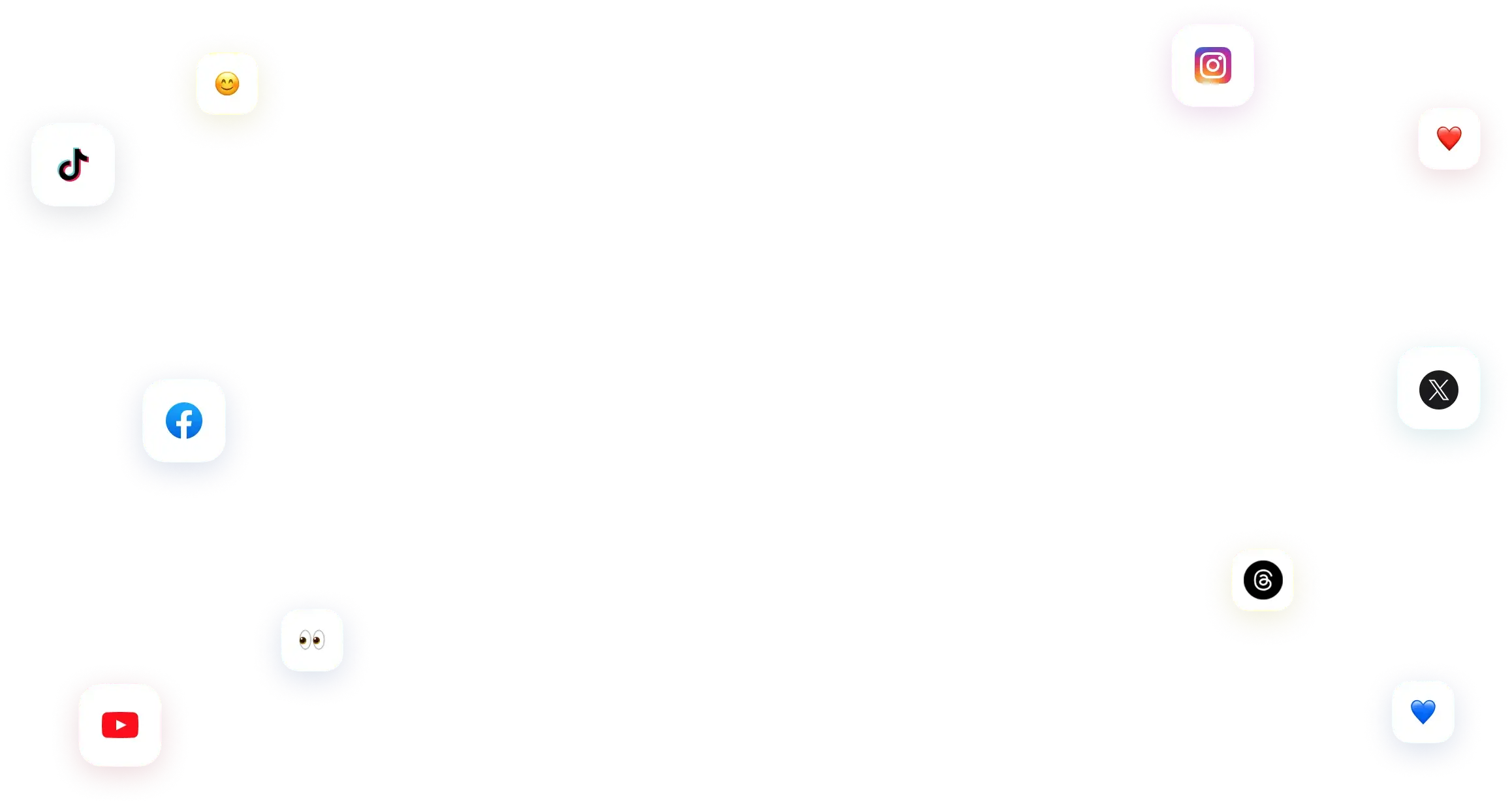
You have many things to do.
Let us help you with social media.
Use our free plan to build momentum for your social media presence.
Or skip ahead and try our paid plan to scale your social media efforts.
P.S. It will be a piece of cake 🍰 with Vista Social
Subscribe to our Newsletter!
To stay updated on the latest and greatest Social Media news. We promise not to spam you!


